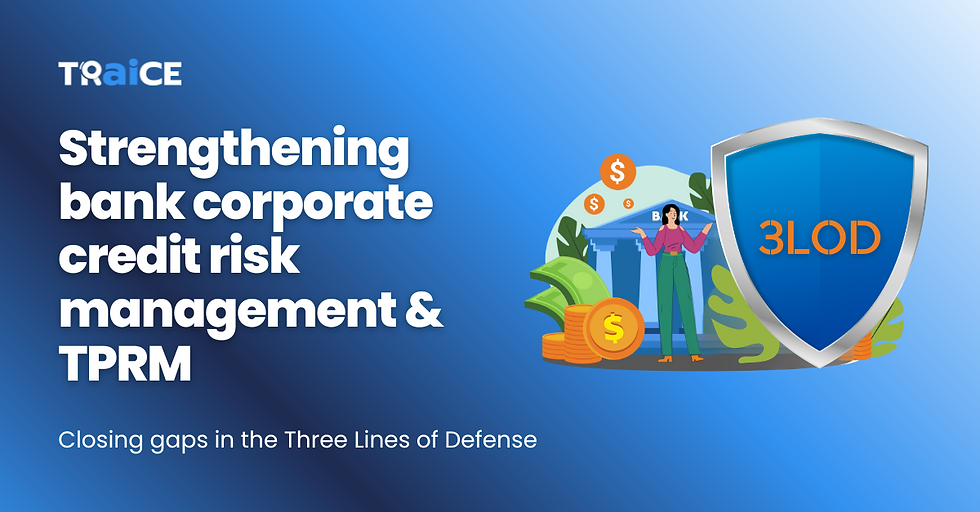5 Risk management lessons to learn from the Credit Suisse debacle
- Betsy Jacob

- Apr 21, 2021
- 6 min read
Updated: Jul 25

All is not well at Credit Suisse. The 165-year-old investment banking company stands to lose a whopping $7 billion dollars due to faulty investments. The recent crisis has brought the credit risk management industry into sharp focus once again. In a somber statement regarding the financial fiasco, the bank’s CEO Thomas Gottstein said, “Serious lessons will be learned.” Whether they learn their lessons or not remains to be seen. It is a good idea for us, however, to learn some corporate credit risk management lessons from their mistakes (lest we make them ourselves tomorrow). As Eleanor Roosevelt famously put it, “Learn from the mistakes of others. You can’t live long enough to make them all yourself.”
The Credit Suisse crisis explained
One of only 9 bulge bracket (multi-national and multi-service offering) banks in the world, Credit Suisse is a pantheon in the banking industry. That said, they are no strangers to financial gaffes and scandals. Since 2013, the company has stumbled from one business debacle to another. These missteps include a spying scandal, indulging in tax evasion tactics, and getting involved in a money-laundering scheme, just to name a few. Their recent slipups cap a series of miscalculations and errors in judgment.
It all began in late November of 2020 when the investment company had to write off over $400 billion to a collapsing hedge fund called York Capital. The write-down saw Credit Suisse close out the year with a fourth-quarter loss.
The Swiss bankers were probably hoping that the new year would bring them new luck. Sadly, that was not to be.
In March 2021, Greensill Capital, a financial services company to whom Credit Suisse lent $140 million, collapsed. The bank managed to recover only about half of what it lent to the failed company. Then less than a month later, Archegos, a private investment firm that Credit Suisse bet heavily on, crumbled. The triple strikes have caused the bank’s shares to plunge by over 20%. Additionally, two of its top executives resigned. These fallouts along with the ongoing Coronavirus pandemic threatens to make this an ‘Annus Horribilis’ for the company.
5 Lessons every risk manager can learn from Credit Suisse
Lesson 1: Don’t ignore the warning signs
To say that Credit Suisse had warning signs but ignored them is a gross understatement. The beleaguered bank had not one, not two, but multiple red flags pop up warning them to pull back on their investments. What’s more, some of these forewarnings came even before the company made the initial investment.
Back in 2017, while the company pondered a Greensill investment, several members of its credit-structuring contingent lobbied against it. Their major concern was that a chunk of Greensill’s assets was tied to British steel magnate Sanjay Gupta. Gupta was at the center of a 2016 shipment scandal that saw four banks cut their ties with him. Then in 2018, GAM, a rival asset management company, suspended its ties with Greensill. This was followed by the German financial regulatory body, BaFin, flagging the hedge fund for impropriety (they have now filed a criminal case against Greensill for balance-sheet manipulation).
Credit Suisse chose to ignore these red flags and look the other way. In October 2020, Greensill asked the bank for a $140 million loan, which they agreed to. The rest, as they say, is history.
Even in the case of Archegos, Credit Suisse had plenty of warning signs. Archegos is run by Bill Hwang. In 2012, Hwang was convicted by the SEC on charges of market manipulation and insider trading. Interestingly, Hwang has a history of making iffy financial bets, having previously helmed a failed hedge fund called Tiger Asia. These are facts Credit Suisse executives were aware of but chose to belittle, nonetheless.
Lesson 2: Learn from past mistakes
The saying, ‘once bitten, twice shy’ is probably not a proverb Credit Suisse adheres to. As mentioned before, this is not the first time the bank has defaulted. The company played its part in the 2008 financial crisis by wrongly insuring mortgage-backed securities; a misstep that saw them paying a $5.8 billion fine to the US Department of Justice.
Then in 2013, the bank lent $2 billion to three companies in Mozambique, a transaction that ultimately involved them in an image-tarnishing money-laundering scandal. Just as with their present-day crisis, the Swiss company had multiple warning signs even before they finalized the deal. For one, the head of their African division, Fawzi Kyriakos-Saad warned the bank not to get involved with the corruption-prone companies. For another, their credit-structuring unit flagged many irregularities in the deal. The bank stands to lose over $600 million from the flawed deal. To make matters worse, the Mozambique government is now suing them.
Given their infamous history, one would think that the investment risk gatekeepers at the bank would pay more attention to alarm bells when they rang.
Lesson 3: Know when to derisk
When it comes to spectacular business implosions, very seldom is it a bolt from the blue. Usually, the writing is on the wall long before the collapse happens. Credit Suisse saw the signs but was slow to react. Their competitors, on the other hand, acted promptly. Like rats leaving a sinking ship, they bailed out on their faulty investments quickly, keeping their profit margins and reputations largely intact.
When things started unraveling at Archegos, executives at the bank addressed ways to reduce their exposure. Talks of raising the margin requirements were initiated but not acted upon. It must be said that Credit Suisse was not the only company to invest in Archegos. Lenders such as Nomura, Deutsche Bank, Morgan Stanley, and Goldman Sachs did too. But while their competitors pulled out of their investments at the first signs of trouble, Credit Suisse’s take-it-slow approach saw them bear the brunt of the losses. The investment company should have been a lot more proactive with its risk assessment and management.
Lesson 4: Don’t skimp on risk assessment
Last year, Credit Suisse’s new CEO, Thomas Gottstein put in place several restructuring and cost-cutting initiatives. Industry experts estimated the initiatives would save the company over $400 million annually. One of these restructuring moves was to merge the departments of compliance and risk into a single unit. Could this have been the catalyst to their recent financial missteps? The ongoing post-mortem at the company is likely to reveal if that is so or not. What is certain, however, is that the bank did try to cut costs in the investment risk department. Unfortunately for them, they paid dearly for it by losing all that they saved with restructuring and then some.
Lesson 5: Use an early-warning, daily risk-monitoring tool
Being an investment manager is a tough job. He or she typically has hundreds, if not thousands, of accounts to keep an eye on. Within each account, managers must monitor myriad KPIs to assess a customer’s business health. Additionally, they must keep an eye out for metrics such as social indexes, sentiment scores, FICO scores, and so on. Only then do you get a complete picture that facilitates early risk identification and monitoring. It is definitely a herculean task; one that is more fit for a machine than any human.
It is unclear if Credit Suisse had technological support for their risk assessment needs or not. Being an enterprise company, it is likely they did. What is clear is that they did not make full use of it. Risk managers can benefit from having an AI-augmented system that will do the hard work of monitoring important business metrics for them. Applications such as TRaiCE monitor and report on key indicators daily, essentially risk-analyzing your entire portfolio every single day. All you need to do then is act on the system-generated alerts, making investment management that much easier.
Conclusion
The repercussions of Credit Suisse’s financial involvements may not be as far-reaching as that of Lehman Brothers in 2008. They are, however, a wake-up call for the company and for the credit risk management industry as a whole. Only time will tell if the company can indeed learn its lessons and build a corporate culture that is more focused on risk management. In the meantime, let's not repeat their mistakes.











Comments